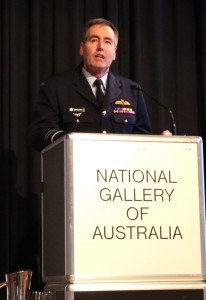2014-04-06 By Robbin Laird
At the Williams Foundation seminar entitle Air Combat Operations: 2025 and Beyond, Air Marshall Geoff Brown, the Chief of Staff of the Royal Australian Air Force provided a sober and challenging perspective on the way ahead. He warned that preparing for future threats and challenges was always challenging and certainly applied to the decade ahead.
Although proud of the efforts being made on behalf of investments in the re-set of the RAAF, he underscored throughout that the challenge of shaping effective concepts of operations and training, training, and training were crucial to any success in real operations.
He noted at the outset, that the struggle to develop bombers in the 1930s was a difficult one, but that when the new bombers were actually used in World War II, they were not used as envisaged when they were built.
I would like to inject a word of caution here at the beginning of this seminar. The caution comes from the eminent RAF historian of the strategic bombing campaign against Germany in World War II, Sir Noble Franklin. In a conference at the USAF Academy in 1968 he reviewed the development of the four engine bomber force – the standout examples being the American B-17 and the British Lancaster.
He noted that only the Americans and the British had persisted through the 1930s with the effort of thinking about and developing these aircraft along with their bombing doctrines over the long capability development process. He noted that the way these platforms were eventually employed, bore little resemblance to the concepts created during the development process. He said;
If there is a moral in all this, it is surely that strategic thought and strategic planning in peacetime are necessary and productive processes, provided the realization is ever present that peacetime plans especially for the employment of new weapons will not, in war, work out in accordance with expectation.
(For our look at the 1930s analogy see our Special Report on the B-17:
https://sldinfo.com/the-b-17-and-its-continuing-legacy/).
The Air Marshal then turned in his remarks to the question of the coming of the F-35 and what it meant for the RAAF.
Why is Australia acquiring the F-35?
With so much capability inherent in generation 4.5 fighters, it has been often asked why do we need 5th generation?
The answer to this is simple: we need to ensure we conduct tomorrow’s air combat operations with tomorrow’s capabilities.
Historical examples highlight loud and clear that today’s technology won’t be suitable in 2025, and certainly not in 2035.

He highlighted the centrality of the decision superiority inherent in the systems of the aircraft.
But underscored that training and effective concepts of operations were necessary to achieve a latent advantage.Credit Photo: Second Line of Defense
And his discussion of the F-35 focused on a key element which will become evident as the F-35s in the Pacific becomes a fleet of enablers for deterrence in the depth: decision making superiority.
To achieve decision superiority in 2025 and beyond, Air Combat Operators will need to be able to see who and what is in the area of operations, with very few limits to arcs of coverage.
The fusing of multi-spectral sensors and electronic support must enable targets to be detected without the knowledge they are being tracked.
The cueing of capabilities must not be limited to on-board sensors; they must be available from multiple off-platform sources.
The networking capabilities of these future air combat assets must be a force multiplier.
They must be able to feed, and be fed from, multiple sources.
The end result is that the pilot must be able to focus solely on the fight, not allocating time and effort to managing data that supports the fight.
As the F-35 systems become realities, concepts of operations will change significantly and here the Air Marshall sounded a bit like Admiral Halsey who focused constantly on the importance of what he called, “training, training, and training.”
New capabilities breed new methods, and how a 5th generation fighter undertakes these missions in 2025 and beyond are unlikely to resemble yesterday’s air combat operations. In future, as it is now, the ability to integrate all the fundamental inputs to capability will still be what determines relative combat effectiveness.
The ability to fly an aircraft does not mean you have the ability to fight the aircraft.
This is never more so than in 5th generation fighters.
This is where training will be so important to our success in future air combat operations.
(On the centrality of training for the decade ahead see the following:
He underscored that a shift from 4th to 5th generation fighters was not simply a transition in technologies but a “generational shift for everybody involved.” And clearly a key reason to acquire the F-35 is to get on the right side of generational change.
History tells us some things with relative certainty about air combat operations in 2025 and beyond.
Importantly, it tells us that technologies will have evolved markedly by 2025, making it essential to acquire capabilities with future growth. 5th generation capabilities, such as the F-35 Joint Strike Fighter, offer a quantum leap in air power capabilities over their compatriots,
The missions they will undertake may not be new, but the capabilities 5th generations fighters bring will vastly change the character and effectiveness of how the missions are undertaken.
The complete presentation of the Air Marshal can be found on The Williams Foundation website at the following location:
http://www.williamsfoundation.org.au/node/197
And for our Special Report on Australian defense modernization see the following:
And for our interview with the head of the Italian Air Force on some of the same issues discussed by Air Marshal Brown see the following:
https://sldinfo.com/a-21st-century-approach-to-airpower-the-italian-air-force-and-the-f-35/

